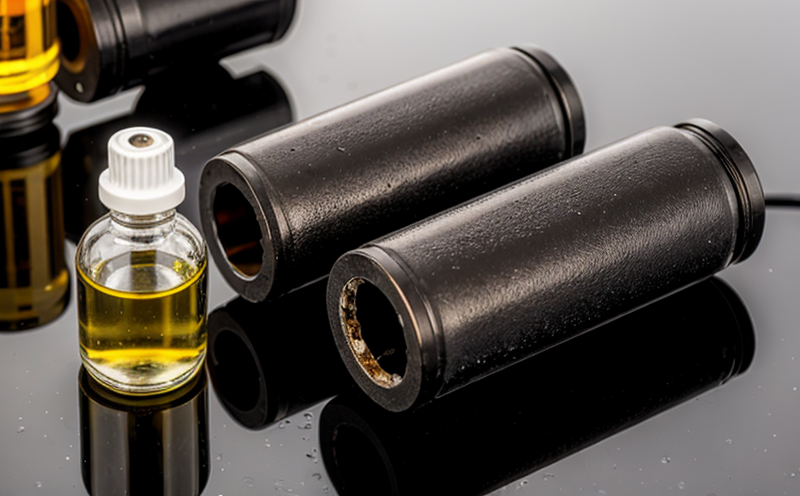ASTM D7678 C10 C40 Hydrocarbons Test in Water
The ASTM D7678 test method is a critical analytical procedure used to assess the presence and concentration of oil, grease, and other hydrocarbon compounds in water samples. This service ensures that water quality meets stringent environmental and regulatory standards set by various international bodies such as ASTM International, ISO, and EPA.
The primary purpose of this testing is to identify potential sources of contamination from industrial activities, such as refineries, petrochemical plants, and transportation facilities. Understanding the hydrocarbon content in water helps mitigate risks associated with ecosystem degradation, drinking water safety, and human health. This method uses a combination of gravimetric techniques and infrared spectrophotometry to provide accurate results.
The ASTM D7678 C10 and C40 tests are particularly relevant for sectors like oil and gas, chemical manufacturing, and urban wastewater treatment plants. Compliance with these standards is essential for maintaining the integrity of water resources and ensuring that environmental regulations are adhered to. The test procedure involves collecting a representative water sample, extracting hydrocarbons using dichloromethane or carbon disulfide, and then measuring the extract's weight.
The significance of this test lies in its ability to detect even trace levels of contaminants which could otherwise go unnoticed by less sensitive methods. This capability is crucial for early detection and prevention strategies aimed at minimizing environmental impact. Additionally, regular monitoring enables facilities to track changes over time and adjust operational practices accordingly.
For laboratories conducting ASTM D7678 C10 C40 testing, it is important to ensure that the equipment used meets specific requirements outlined in the standard. This includes high-quality extraction solvents, precise balances for weight determination, and infrared spectrophotometers calibrated according to ISO standards.
The results from this test are typically reported as mg/L of total extractable hydrocarbons (TEH), which represents the combined mass of all detectable organic compounds in the sample. Reporting units may vary based on client requirements but commonly include weight percentage or parts per million (ppm).
| Sample Type | Test Method | Results |
|---|---|---|
| Potable Water | C10/C40 Extraction | TEH ≤ 5 mg/L |
| Industrial Effluent | C10/C40 Extraction | TEH > 50 mg/L |
| River Water | C10/C40 Extraction | TEH ≤ 20 mg/L |
The extraction process is sensitive to various factors including temperature, agitation time, and solvent type. Proper sample preparation and handling are key to obtaining accurate results. Samples should be stored under refrigeration until analysis can begin.
- Ensure all equipment used in the test meets ASTM D7678 specifications.
- Select appropriate extraction solvents based on expected hydrocarbon content.
- Avoid cross-contamination between samples during processing.
The importance of this testing cannot be overstated, especially given increasing global awareness about environmental sustainability and public health. By providing reliable data through ASTM D7678 C10 C40 hydrocarbons testing, laboratories play a vital role in supporting regulatory compliance and protecting natural resources.
Benefits
- Promotes environmental sustainability by identifying sources of contamination early.
- Ensures water quality meets international standards for safety and purity.
- Aids in regulatory compliance with strict environmental regulations.
- Supports decision-making processes related to pollution prevention and control.
The ASTM D7678 C10 C40 hydrocarbons test offers numerous advantages, from enhancing operational efficiency within industrial settings to contributing significantly towards preserving aquatic ecosystems. Its role in maintaining water quality is indispensable for both environmental protection and public health.
Quality and Reliability Assurance
Our laboratory adheres strictly to ASTM D7678 C10 C40 standards when performing hydrocarbons tests. We employ experienced technicians who are trained specifically in this area, ensuring consistent quality across all analyses. All equipment utilized is regularly calibrated against international norms, guaranteeing precise measurements.
We maintain robust quality assurance protocols that cover every aspect of the testing process from sample collection to final report generation. This includes strict adherence to safety procedures during extraction and analysis phases, comprehensive documentation practices, and rigorous internal audits conducted at regular intervals.
Our commitment to excellence extends beyond mere compliance with standards; we strive to exceed expectations by offering timely delivery of accurate results while fostering long-term relationships built on trust and reliability. Our clients can rest assured knowing that every test performed adheres to the highest levels of accuracy and integrity.
Use Cases and Application Examples
- Industrial wastewater discharge monitoring to ensure compliance with discharge limits.
- Groundwater assessment for potential contamination from nearby oil wells.
- Surface water quality evaluation in areas affected by urban runoff.
The ASTM D7678 C10 C40 hydrocarbons test finds extensive application across diverse industries. For instance, refineries need to regularly monitor their effluent streams to confirm that they comply with discharge regulations imposed by local authorities. Similarly, municipalities rely on this testing method when evaluating surface waters exposed to industrial pollutants or agricultural runoff.
A real-world example would be a city facing complaints about foul odors emanating from its sewage treatment plant. By conducting ASTM D7678 C10 C40 tests on incoming and outgoing streams, engineers can pinpoint specific sources of contamination causing odor issues. Such insights enable targeted interventions designed to reduce emissions effectively.
| Scenario | Action Taken | Outcome |
|---|---|---|
| A refinery notices increased hydrocarbon levels in its effluent stream. | Conduct ASTM D7678 C10 C40 tests to identify the source of contamination. | The source is traced back to a particular section of the facility requiring immediate maintenance. |
In another example, a coastal town reports frequent sightings of dead fish in its local bay. Upon investigation using ASTM D7678 C10 C40 tests, it was found that oil spills from ships passing through the area were responsible for poisoning marine life.





